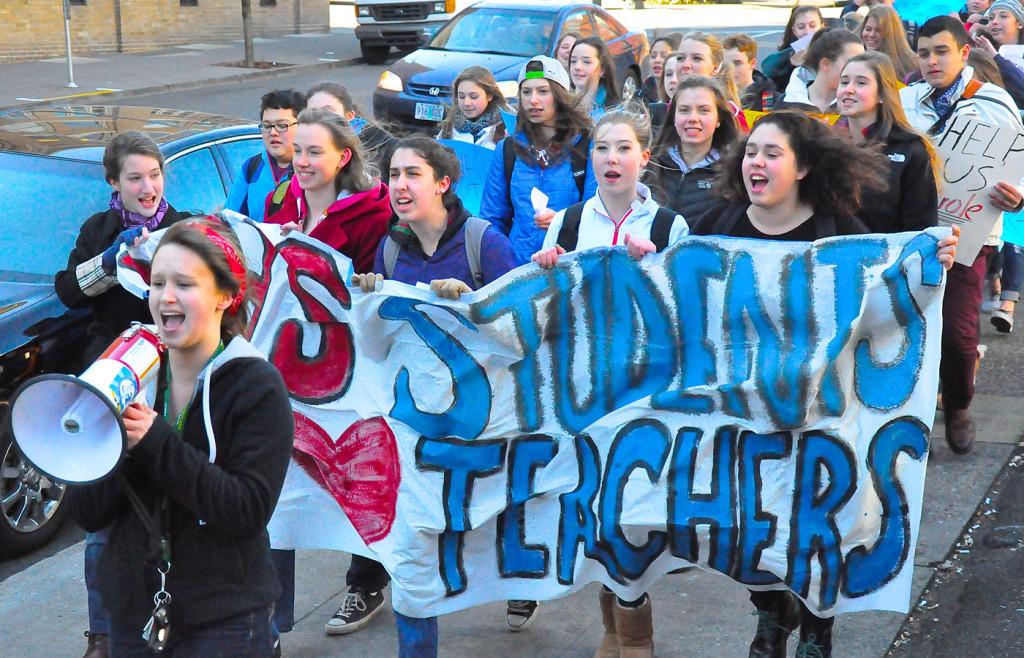Students Walk Out in Support of District-Wide Protest
The Lincoln walkout was part of a district-wide protest that included Cleveland (where an estimated 600 students left class), Wilson, Grant, Madison, and Jefferson. Over 1,000 students participated.
At exactly 12:45 p.m yesterday, over 100 students walked out of classes at Lincoln to protest the stall in teacher-district contract negotiations.
They gathered in the courtyard holding signs, cheering, and chanting in support of the Portland Association of Teachers. From there, students marched to the Arlene Schnitzer Concert Hall, where teachers would later vote for or against a strike. The group then continued to Pioneer Courthouse Square.
Chants of “Hey, ho, overcrowding’s got to go” and “One, two, three, four, students are more than a test score” were shouted by protesters as they walked through downtown Portland. Homemade signs with phrases such as “Walk all over my education, I’ll walk out of class” and “Student power” were held up by many demonstrators.
About 70 Lincoln students were present at the concert hall and were joined by about 20-30 students from Metropolitan Learning Center before proceeding to Pioneer Square. At the square, students from Wilson and Cleveland joined the group. “I support this because the school has been going further towards not offering me the education that I need, and that has got to stop,” one unidentified MLC student said.
Leading the protest were student organizers and Lincoln seniors Emma Hoffman, Sara Newman, and Kiley Yuthas. “I organized the protest because I was tired of Lincoln students having a passive voice in their education,” Hoffman said. “It’s time we take a stand.”
According to Newman, the protest aimed to make student voices heard in the negotiations. “The goal of the walkout was to wield the only real power the students have,” she said. “We were much more student-oriented than union-oriented, which is important because I think students need an opportunity to be heard during this process. Both sides of negotiations like to use ‘students’ best interests’ as an excuse to push for what they want, and quite frankly neither of them seem to really be serving our interests.”
At around 12:30 p.m., just before the protest started, an email was sent out by Principal Peyton Chapman assuring parents that although the administration “celebrate[s] student civic involvement,” the administration “hope[s] that students will not forfeit scarce instructional time to leave the building during classes.” The email also said students who walked out would be marked absent for class, and athletes marked absent would not be eligible to play that day, as per OSAA policy.
While all class groups were represented at the protest, freshman and sophomores seemed to be the majority. “We have a good school and not enough time in the day,” freshman Claudia Chapman said. “If we don’t have school [because of a strike], how can we be successful in class?”
Students had a variety of reasons for supporting the demonstration. “My education is really important to me, and although I’m graduating this year, my sister will be in the system next year” senior Carmen Alfaro said. “[The state of negotiations] is unacceptable.”
Many students, however, chose to remain in class. “The solutions that the teachers’ union have raised will not help the students in their education,” said one Lincoln student when asked why he did not walk out. “Many other countries that perform higher than us, like Japan and Germany, spend far less per student on education. Japan ranks extremely high and their class sizes usually are around 30-45 students.”
Teachers were divided about the protest. In some classes students were told they should not attend, while others were more supportive of the walkout. “I encouraged students to, if participating, participate for [their] own reasons,” Fred Fox, history and economics teacher, said.
Leading up to the protest, student organizer Hoffman created a Facebook page to coordinate activities and invite students to educate themselves on the issue. Links to a summary of demands from each side were posted, as well as copies of the current proposal. The page generated comments from students, alumni, and even others not affiliated with the school, all with differing opinions.
The protest ended at about 1:30 p.m., early enough for students to return to school to attend eighth period. Some students, however, went to Cleveland to continue demonstrating. Lincoln student organizers encouraged classmates to attend a later demonstration taking place at 5:30 p.m. outside the concert hall to protest before the strike vote.
Overall, Newman said the protest was meant to let the district know students care. “The district has to know that we’re aware of what’s going on and we care about our education,” she said. “Somewhere along the line it is very easy for them to lose sight of the real objectives and get swept up in the politics of contracts.”

